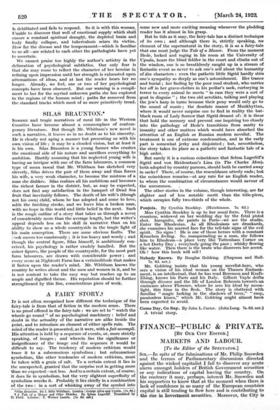A FAIRY STORY.t
IT is not often recognized how different the technique of the fairy-tale is from that of fiction in the modern sense. There is no proof offered in the fairy-tale : we are set to " watch the wheels go round " of no psychological machinery : belief and doubt in the actuality of the narrative are alike beside the point, and to introduce an element of either spells ruin. The mind of the reader is presented, as it were, with a fait accompli. His attention is held by a sequence of events, or, more strictly speaking, of images ; and wherein lies the significance or insignificance of the image and the sequence it would be difficult to say. The tendency of modern criticism would trace it to a subconscious symbolism ; but subconscious symbolism, like other tendencies of modern criticism, must be taken with a grain of salt. To a certain extent it lies in the unexpected, granted that the surprise rest in getting more than we expected—not less. And to a certain extent, of course, it does lie in symbolism, but the very slightest superfluity of symbolism wrecks it. Probably it lies chiefly in a combination of the two : in a sort of whisking away of the symbol into *Sias Braggton. By J. Mille Whithem. London : George Allen and Galvin. [7e. ed.' t A Tale of a Manor and Other Sketcher. By Pettus Lagerldt. Translated by C. Flat Lteidon':- T. Werner Laurie. (U. 6d. net}
some new and more exciting meaning whenever the plodding reader has it almost in his grasp.
But be this as it may, the fairy-tale has a distinct technique of its own ; and although there is, strictly speaking, no
element of the supernatural in the story, it is as a fairy-tale that one must judge the Tale of a Manor. From the moment
Hede, locked and raging in his room at the University of Upsala, hears the blind fiddler in the court and climbs out of the window, one is so breathlessly caught up in a stream of fantastic event as never to ask one's self about the humanity of ,the characters : even the pathetic little Sigrid hardly stirs one's sympathy so deeply as one's astonishment. Her trance and burial ; her finding by the poor mad student, who carries her off in her grave-clothes in his pedlar's sack, curtseying in terror to every animal he meets " in case they were a sort of goat in disguise " ; the two old acrobats, talking and playing the jew's harp in turns because their pony would only go to the sound of music ; the desolate manor of MUnkhyttan, where it would never surprise one to find in reality the bat- black room of Lady Sorrow that Sigrid dreamt of: it is these that hold the memory and prevent one inquiring too closely into the pathology of Hede's transitions . from sanity to insanity and other matters which would have absorbed the attention of an English or Russian modern novelist. The treatment is one of extreme condensation, and in the early part is somewhat jerky and disjointed ; but, nevertheless,
the story takes its place as a pathetic and fantastic tale of a high order.
But surely it is a curious coincidence that Selma Lagerlors
Sigrid and von Heidenstam's Lina (in The Charles Men), both adopted by country parsons, should both be carried away
in sacks? There, of course, the resemblance utterly ends; but the coincidence remains—at any rate for an English reader, to whom the combination of circumstances would savour of the uncommon.
The other stories in the volume, though interesting, are far slighter and of less notable merit than the title-piece, which occupies fully two-thirds of the whole.


































































 Previous page
Previous page